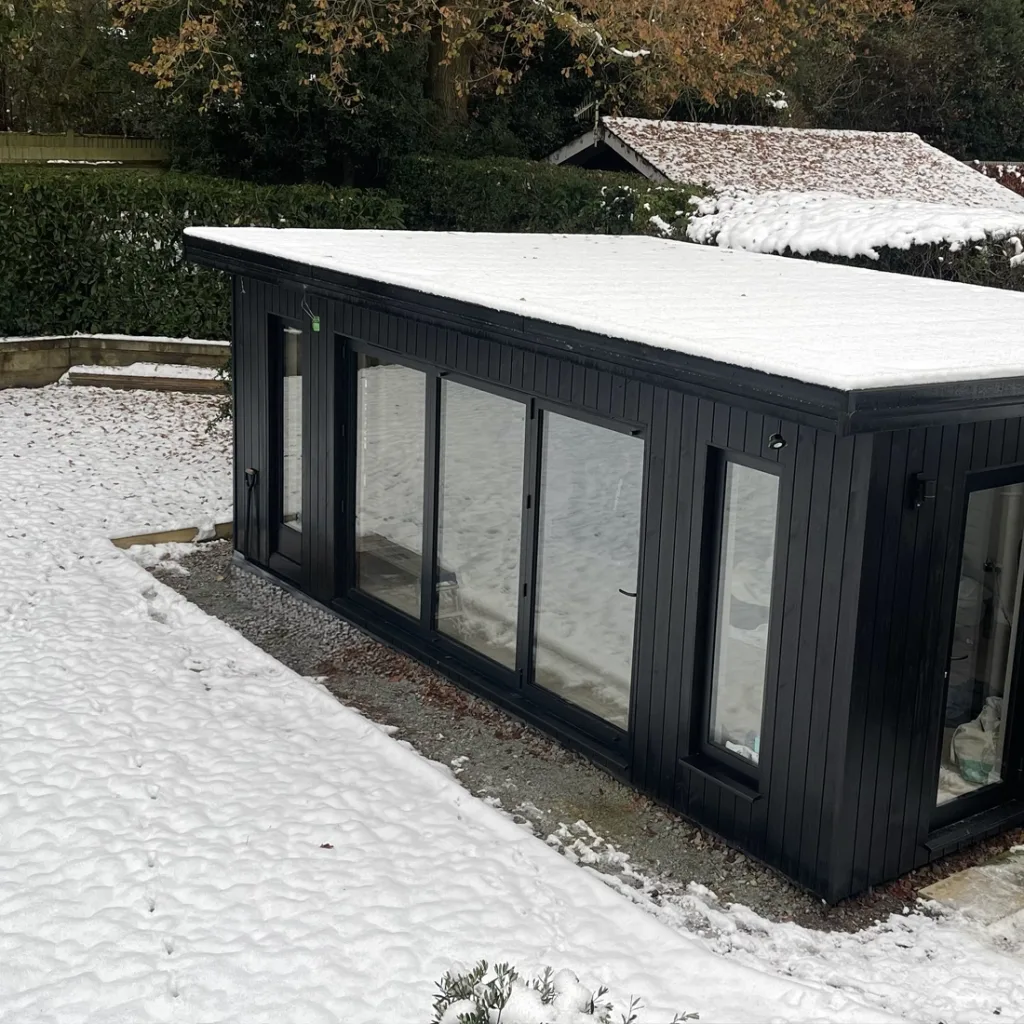A garden room is an investment which you want to enjoy year-round, which means that heating is a key consideration. However, with the rising cost of living, we know you don’t want to throw money down the drain.
This guide will help you understand the best (and cheapest) ways to heat your garden room. By following some simple but essential steps, you can save money whilst keeping your garden room warm during the colder months.
How to keep a garden room warm:
- Insulation
- Double-glazing
- Underfloor heating
- Radiators and portable heaters
- Hot air fan
- Solar panels
How to insulate a garden room
It is hugely important to make sure that your garden room, garden gym, or garden office is built with adequate insulation, otherwise, you will end up heating your entire garden.
When choosing a garden room provider, make sure the building they offer comes with enough insulation to keep you warm and comfortable during cold spells. Ask them what they plan to insulate the floor, walls, and roof with.
As a minimum, the floor and walls should have 75mm of insulation and the roof 100mm. This will ensure that heat loss is kept to a minimum.
Choosing the right type of garden room insulation
Polyurethane insulation (PIR) boards, or foam boards, are one of the most common and energy-efficient types of insulation, consisting of a foam board with an aluminium foil outer layer. They are easy to cut to size and a thin layer will provide what you need, however they can create a lot of dust.
Mineral wool insulation is another option with slightly lower energy efficiency, however, it is flame resistant and helps dampen any sound coming through walls. It’s also more flexible than foam boards and can be manipulated into tricky gaps and dimensions.
Fibreglass insulation has the same properties but is made out of fibreglass instead of natural materials like rock or basalt used in mineral wool. This is generally less soundproofing and fire-resistant but can be cheaper.
Spray foam can be a good insulator for smaller spaces as it expands and fills the smallest gaps, creating an airtight seal. On the other hand, it can be quite expensive and generally needs a professional to apply it to a whole garden room.
Other options include cavity slab insulation and cellulose insulation.
Considerations for installing garden room insulation
Remember that when selecting your type of insulation, the higher the R-value, the better the insulation and more efficient it will be to heat your garden room.
Sometimes the type and thickness of insulation you can install depends on the local building regulation, which can vary depending on where you live and how cold it is. At the Garden House Company, we provide design and planning services to advise you on how to navigate these kinds of requirements.

Double-glazing for a garden room
The other consideration is the windows and doors that are used. If the windows and doors are not at least double-glazed then you might as well throw money out the door. You’ll also notice condensation which can lead to mold, as well as more noise from outside.
There are many different types of double-glazing glass you can choose, from low-E glass that is designed specifically to minimise heat loss to argon-filled glass that has a layer of gas in between panes to provide further insulation. Ultimately, the choice depends on your budget but any of these is better than nothing.
The Garden House Company’s builds all come with double-glazed windows and doors.
Heating options for your garden room
Once you’ve sorted out insulation for your garden room, you may need to consider additional heating for the colder months. Your choice will come down to budget, how insulated your build is, and the size of the garden room.
Radiators and portable heaters
Portable heaters and radiators are one of the best ways to heat a garden room on a budget, as you can only use them when you need them and move them around to get the benefit where you need it.
Options include more pricey electric radiators, costing around £500 pounds, to oil-filled radiators costing around £50. The cheapest way to heat a garden room, however, is a portable fan heater, or convection heater, which can cost as little as £15.
Underfloor heating
Arguably the best way to distribute heat around your garden room, underfloor heating can also be more cost-effective in the long term and doesn’t take up any extra space like a heater. Installation can be costly though so it depends when and how frequently you’ll be using the garden room. For example, one of our clients opted for remotely controlled underfloor heating in her garden yoga studio for the colder winter morning classes.
Air conditioning
Most people associate aircon with cooling down a room, however, some models can be used in reverse to heat up your garden room. These are often referred to as “reverse cycle” air conditioners or heat pumps.
These provide a single solution for year-round temperature control.
Solar
Another option for heating your garden room, solar panels installed on the roof can generate the renewable energy needed. Again this depends on how frequently you’re heating your property – the costs associated with getting a solar panel specialist supplier may not be worth the payoff.
Take a look at our other blog post on garden room lighting to see how solar can improve your exterior lighting.
How much to heat a garden room
The cost to heat your garden room comes down the the level of insulation, the size, and how you’re heating it in colder months. Here are some estimated costs per hour depending on the type of heating you use:
- Portable fan heater: 17p (500W) – 68p (2kW)
- Electric radiator: 19p (750W) – 50p (2kW)
- Oil-filled radiator: 9p (400W) – 56p (2.5kW)
- Underfloor heating: 11p (small, 3m²) – 56p (large, 15m²)
- Reverse cycle aircon: 7p – 15p
- Solar: £0 (after install) – no running cost, but high upfront installation and energy available depends on sunlight
These estimates are based on an analysis of web sources including Homebuilding, Electric Radiators Direct, Bathroom Takeaway, TM Hughes & Son, and Consumer Rights.
Garden room heating calculator
Understanding how many kilowatts you need to heat your space will help you decide which heating source is best. HeatMySpace has a Watt Calculator to help you do this whilst HeaterShop’s calculator will estimate how many radiators or portable heaters your room will need to maintain a temperature of 21℃.

Heating your garden room with the Garden House Company
If you follow these simple but essential steps, heating your garden room and keeping it warm and cosy will save you money. You won’t have to crank up the heater to full power just for the privilege of sitting in a cold room in your garden. And you will enjoy your garden room all year round.
The Garden House Company can help you plan the best way to heat your garden room. Learn more about our design and planning services or contact us today!





